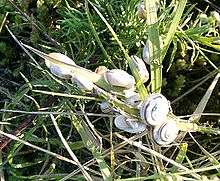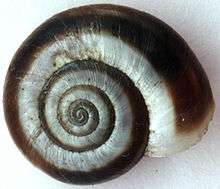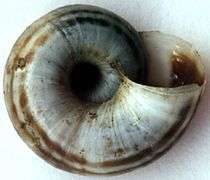Xerolenta obvia
Xerolenta obvia is a species of air-breathing land snail, a terrestrial gastropod mollusk in the family Geomitridae, the hairy snails and their allies.
| Xerolenta obvia | |
|---|---|
 | |
| Scientific classification | |
| Kingdom: | |
| Phylum: | |
| Class: | |
| (unranked): | clade Heterobranchia clade Euthyneura clade Panpulmonata clade Eupulmonata clade Stylommatophora informal group Sigmurethra |
| Superfamily: | |
| Family: | |
| Genus: | |
| Species: | X. obvia |
| Binomial name | |
| Xerolenta obvia | |
| Synonyms | |
|
Helicella obvia | |
Distribution
This land snail occurs in European countries[2] including Hungary, Bulgaria, Czech Republic, Italy, Poland, Slovakia, Ukraine,[3] Canada (Bethany, Ontario, Canada first detected in 1969 and 1972;[4] at least 23 occurrences in southern Ontario as of 2015[5]), United States of America (Wayne County, Michigan Detected in 2002 - B. Sullivan) and others.
This species in the USA is considered to represent a potentially serious threat as a pest, an invasive species which could negatively affect agriculture, natural ecosystems, human health or commerce. Therefore it has been suggested that this species be given top national quarantine significance in the USA.[6]
Description
Shells of Xerolenta obvia are medium-sized (7–10 mm high, 14–20 mm wide) and relatively flat. In the adult stage, 5 to 6 turns are present. These shells are usually thick and smooth, with a white or yellowish-white basic color and quite variable, dark brown to almost black bands. The body is yellowish-brown.
Life cycle
The size of the egg is 1.5 mm.[7]
Gallery
 Shells of Xerolenta obvia
Shells of Xerolenta obvia Apical view of a shell of Xerolenta obvia
Apical view of a shell of Xerolenta obvia Umbilical view of a shell of Xerolenta obvia
Umbilical view of a shell of Xerolenta obvia
References
- Menke C.T. (1828). Synopsis methodica molluscorum generum omnium et specierum earum, quae in museo Menkeano adservantur; cum synonymia critica et novarum specierum diagnosibus. pp. I-XII [= 1-12], 1-91. Pyrmonti. (Gelpke).
- Fauna europaea
- Balashov I. & Gural-Sverlova N. 2012. An annotated checklist of the terrestrial molluscs of Ukraine. Journal of Conchology. 41 (1): 91-109.
- Grimm, F. W. & Wiggins, G.B. ([1975]). Colonies of the European snail Helicella obvia (Hartmann) in Ontario. The Canadian Field-Naturalist 88 (4): 421–428.
- Forsyth, R.G., M.J. Oldham, E. Snyder, F.W. Schueler & R. Layberry (2015). Forty years later: distribution of the introduced Heath Snail, Xerolenta obvia, in Ontario, Canada (Mollusca: Gastropoda: Hygromiidae). Check List 11(4): 1711. doi: 10.15560/11.4.1711
- Cowie R. H., Dillon R. T., Robinson D. G. & Smith J. W. (2009). Alien non-marine snails and slugs of priority quarantine importance in the United States: A preliminary risk assessment. American Malacological Bulletin 27: 113-132. PDF.
- Heller J. (2001). Life History Strategies'.' in Barker G. M. (ed.): The biology of terrestrial molluscs. CABI Publishing, Oxon, UK, ISBN 0-85199-318-4. 1-146, cited page: 428.